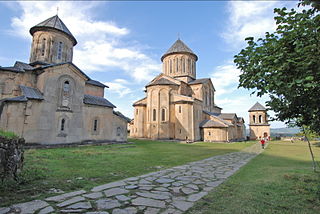
Gelati is a medieval monastic complex near Kutaisi in the Imereti region of western Georgia. One of the first monasteries in Georgia, it was founded in 1106 by King David IV of Georgia as a monastic and educational center.

Varnava Rosić was the Patriarch of the Serbian Orthodox Church from 1930 to 1937. He was born Petar Rosić in Pljevlja, belonging at that time to the Ottoman Empire, on August 29, 1880.

The Patriarchate of Peć Monastery or the Patriarchal Monastery of Peć, is a medieval Serbian Orthodox monastery located near the city of Peja, Kosovo. Built in the 13th century, it became the residence of Serbian Archbishops. It was expanded during the 14th century, and in 1346, when the Serbian Patriarchate of Peć was created, the Monastery became the seat of Serbian Patriarchs. The monastery complex consists of several churches, and during medieval and early modern times it was also used as mausoleum of Serbian archbishops and patriarchs. Since 2006, it is part of the "Medieval Monuments in Kosovo", a combined World Heritage Site along with three other monuments of the Serbian Orthodox Church.

The St. Mark's Church or the Church of St. Mark is a Serbian Orthodox church located in the Tašmajdan park in Belgrade, Serbia, near the Parliament of Serbia. It was built in the Serbo-Byzantine style by the Krstić brothers, completed in 1940, on the site of a previous church dating to 1835. It is one of the largest churches in the country. There is a small Russian church next to St. Mark's.

The Fenek Monastery is the male monastery in the eparchy of Srem of the Serbian Orthodox Church. The monastery is situated near the village of Јаkovo, 25 km from Belgrade, former Municipality of Zemun and now Surčin. Although geographically it does not belong to Fruška gora there is a huge historical connection with Fruška gora monasteries. The monastery church was dedicated to St. Martyr Paraskeva.

Ružica Church is a Serbian Orthodox church located in the Belgrade Fortress, in Belgrade, the capital of Serbia. The original church was built in the early 15th century. It was remodelled in 1869 and fully reconstructed in 1925. It is dedicated to the Nativity of Mary. With its location within the fortress near the water spring of Saint Petka, constant crowds of visitors come - especially on Saint Petka's feast day. It is considered one of the "best loved churches among the faithful".
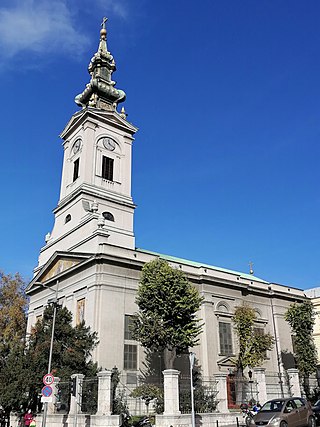
The Cathedral Church of St. Michael the Archangel is a Serbian Orthodox cathedral church in the centre of Belgrade, Serbia, situated in the old part of the city, at the intersection of Kralja Petra and Kneza Sime Markovića streets. It was built between 1837 and 1840, on the location of an older church also dedicated to Archangel Michael. It is one of the most important places of worship in the country. It is commonly known as just Saborna crkva among the city residents. It was proclaimed as a Cultural Monument of Exceptional Importance in 1979.

The Church of St. Achillius or the Arilje Monastery is a Serbian Orthodox church in Arilje, western Serbia. It is dedicated to Saint Achillius of Larissa, a fighter against Arianism and participant of the First Council of Nicaea in 325. The church was built in 1296 by Serbian King Stefan Dragutin of the Nemanjić dynasty and is located in the center of town, on the elevated plateau above the large river valley and the river Moravica and Big Rzav, and represents the most dominant object in the Arilje region.

The Monastery of Saint Archangel Gabriel, also known as the Zemun monastery is a Serbian Orthodox monastery. Its church was built in 1786, on the site of an older church in the Donji Grad neighbourhood of Zemun. The monastery was officially established in 1990.

The Monastery of St. Nicholas is a Serbian Orthodox monastery built by the Grand Prince Stefan Nemanja between 1159 and 1166. It is situated in the center of the historical region of Toplica, near the present day city of Kuršumlija (Serbia), in the upper valley of Toplica river.

The Monastery of the Most Holy Mother of God, also known as Petkovača (Петковача), is a defunct Serbian Orthodox monastery, currently in ruins, built by Serbian Grand Prince Stefan Nemanja sometime between 1159 and 1168. The monastery is located on a plateau between the Kosanica and Toplica rivers, and near the entrance of Kuršumlija.
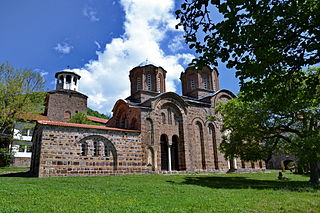
Lesnovo monastery, officially called Monastery of St Archangel Michael and St Hermit Gabriel of Lesnovo, is a medieval monument in North Macedonia. It is perhaps the best preserved endowment of a Serbian noble of the 14th century, with well-preserved frescoes.

Dragana Đorđevic is a Serbian painter who was trained in this traditional craft under the guidance of orthodox nun Porfirija. This Greek nun introduced her to the beauty of byzantine art toward which Dragana inclined ever since. During her over 30 years long career she has researched style of the great late byzantine masters whose monumental frescoes influenced and refined her own work. Her admiration toward Michael Astrapas and Eutychios or Panselinos encouraged her to mimic their styles in order to improve her own skill and only through that acquire particular trait of her art. Today she is praised as someone whose icons are of exceptional quality. Since 1988 Dragana has presented her icons on numerous exhibitions in Serbia and abroad and has participated in a number of art colonies, thus actively participating in defining development of contemporary religious art. She painted two icons of Serbian Patriarch Pavle who was considered saint by many in Serbia even before he deceased in 2009, and whose image is still very well-known. A few years after his death Dragana tried to incorporate his familiar facial features into the traditional technique of icon painting. In 1997 she also became a member of UPIDIV.

The Church of Saint Demetrius or the Church of the Holy Trinity was a Serbian Orthodox church in Budapest, Hungary, located in the Tabán area. It was built between 1742 and 1751 in Central European Baroque style by the Serbian community of Buda, and served as the co-cathedral of the Eparchy of Buda. The building was seriously damaged in the siege of Budapest in 1945, and the ruins were demolished in 1949.

The Greek Church is a Romanian Orthodox church located at 12 Gheorghe Barițiu Street, Brașov, Romania. It is dedicated to the Holy Trinity.
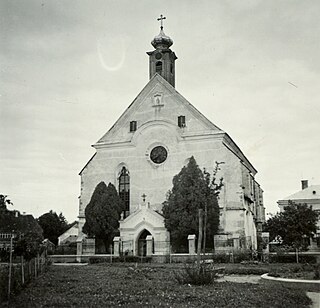
The Entry of the Theotokos into the Temple Church is a Romanian Orthodox church located at 8 Piața Unirii, Bistrița, Romania. It is dedicated to the Entry of the Theotokos into the Temple.
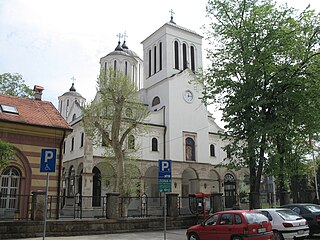
The Holy Trinity Cathedral is the seat of Eparchy of Niš. After the Church of St. Sava and the Church of St. Mark in Belgrade, the Cathedral Church in Niš is the largest in Serbia.

The Church of St. Nicholas in Šid is Serbian Orthodox church in Vojvodina, Serbia. The church is dedicated to St. Nicholas. It is the primary centrally located Eastern Orthodox church in the town and a protected cultural monument. The building was constructed in the second half of the 18th century and completed in 1780. At the time, modern day Vojvodina was a part of the Habsburg monarchy in which Šid was located close to the Ottoman Serbia. At the time of the construction of the Eastern Orthodox church in Šid, Habsburg Monarchy implemented numerous legal reforms such as Declaratory Rescript of the Illyrian Nation and Patent of Toleration which improved legal standing of the Eastern Orthodox subjects.
Dimitrije Bratoglić was a near forgotten Serbian academic painter, merchant and sometime spy for Serbian insurgents during the time of the Serbian Revolution. He was born in Zemun, then part of the Austrian Empire, in late December 1764 according to the Julian Calendar which coincided with early January 1765 according to the Gregorian calendar. Bratoglić attended the Academy of Fine Arts in Vienna in the 1780s. In 1828 he was commissioned by the Serbian Orthodox Church to paint the Church of Sts. Peter and Paul at Sremski Karlovci. Dimitrije Bratoglić painted wall paintings on the vault, pendants and icons on the iconostasis.
Sava Petrović was a Serbian icon painter and portraitist. He was the father of international portraitist Pavel Petrović, the globetrotter.


























